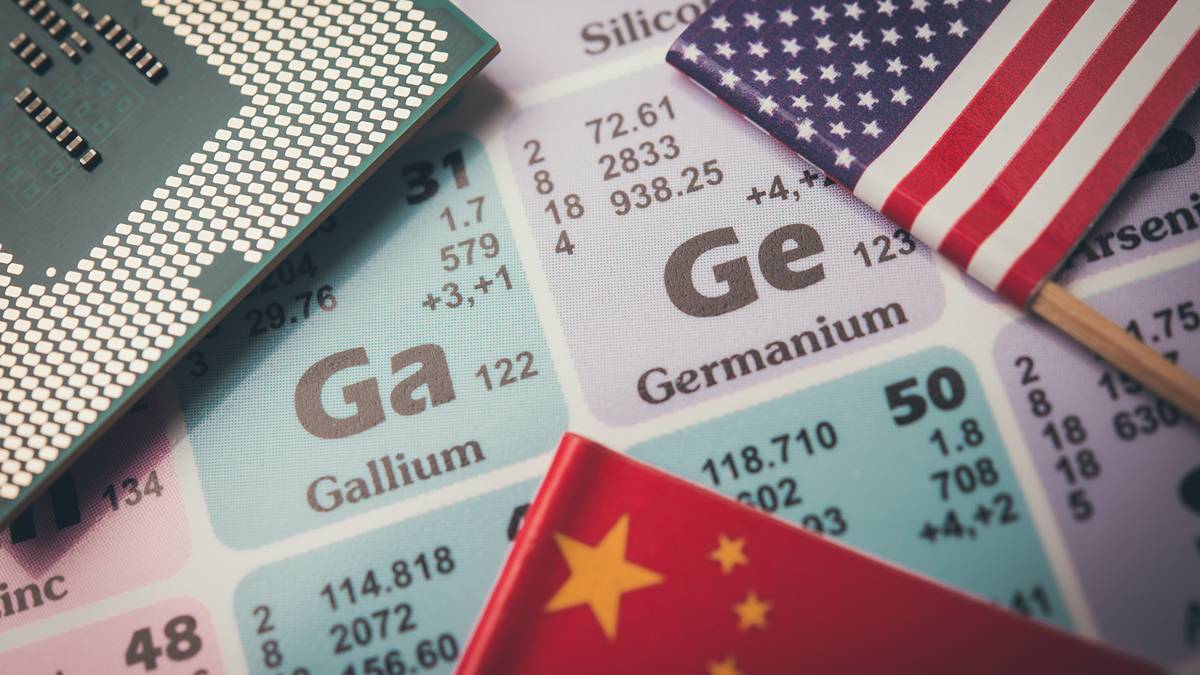Why gallium gambit has made Mt Ridley Mines an overnight market darling

Used in computer chips, gallium is now at the centre of trade tensions between the US and China. Pic: Getty Images
- Gallium prices are rising and the race is on to develop supply outside of China
- While the impact of the China-US trade agreement remains unknown, there’s no doubt that demand is rising
- Mount Ridley has jumped to the front of the development queue with a massive maiden resource
The race is on to develop a gallium supply chain outside of China, which dominates the market.
Like many other critical minerals, China is estimated to control more than 98% of the global gallium market, putting pressure on the West to develop its own supply sources.
CRU Group projects gallium demand to grow from 708 tonnes in 2023 to 1180t by 2030.
China announced export controls on gallium in mid-2023, pushing prices higher to where they remain today.
“When the controls were first announced in July 2023, there was an initial price surge and push to build safety stocks. This took the European price average from US$283 per kilogram in June to US$361/kg by August,” Argus non-ferrous metals deputy editor Sian Morris told a recent webinar.
“Once the controls came into force, exports from China dropped to zero tonnes for August and September before the first export licences were approved, actually quite quickly in October, but exports have varied quite a lot month-to-month since the controls were introduced, sometimes returning to normal levels and sometimes dropping back to zero again.
“This unpredictability … has contributed to higher prices.
“For example, earlier this year, exports fell to zero in May, and we saw prices surge the following month until eventually reaching their current highs at over US$1000 per kilo in Europe.”
Morris said there were several gallium projects outside China in development, but significant volumes were not expected in the near term.
“Argus estimates, based on projects that we are monitoring, that there is the potential to build capacity outside China to over 230t per year, which exceeds China’s exports even before the controls were introduced,” she said.
“That said, it remains to be seen which of these projects will reach production in the next few years or will be economically viable.
“Of course, there’s always the risk that China can open the taps on gallium supply at any time to undercut production in the rest of the world and maintain its market share.
“The spread between domestic Chinese prices and the rest of the world has really ballooned since the export controls came into force, as China has steadily increased its own production capacity and limited exports. China relaxing its export controls would potentially begin to close this gap and cut margins for any new projects outside China.”
Pressing need
Over the weekend, the US and China signed an economic and trade agreement that would “effectively eliminate China’s current and proposed export controls on rare earth elements and other critical minerals”, though the impacts on the market are yet to be fully understood.
Allister Caird, newly appointed CEO of Mount Ridley Mines (ASX:MRD), said there were different ways to view it.
“My feeling is now that this problem has been so widely publicised with respect to critical minerals supply outside of China, I don’t think that any agreement with China is going to be a long-standing agreement,” he told Stockhead.
“I think historically, these agreements are quite short and they can sort of turn on a dime, so my feeling is that this problem needs to be addressed going forward, with or without gallium being in this mix.”
Caird noted that gallium, to his knowledge, was not touched on in the US-China negotiations, but it was in the recent critical minerals deal signed between US President Donald Trump and Australian Prime Minister Anthony Albanese.
The Australian government announced up to US$200 million in concessional equity finance for a gallium project being developed by Alcoa and Sojitz Corporation in Western Australia, while the US government will also make an equity investment.
“That was a conversation that was had just one week prior to the China-Trump discussion,” Caird said.
“I think that China will never be relied on again to the same level as it has for critical mineral supply.
“Obviously, it’s going to take time to develop supply chains outside of China, but even with these agreements in place, I think there will be more conscious decisions to investigate supply chains outside of China.
“With respect to gallium, certainly the intent is to shift the focus towards Western Australia, and I think that’s why Mount Ridley is so well positioned to have such a large resource in the State that has already been earmarked as a hub of gallium supply.”
Right project, right time
Shares in Mount Ridley have exploded since the company reported an initial resource for its Mt Ridley project near Esperance on October 28.
The company reported an initial inferred resource of 838.7 million tonnes at 29.3 parts per million gallium (39.5ppm gallium oxide) for 24,584t of contained gallium, reported at a 25ppm cut-off.
That’s in addition to the project’s existing rare earths resource of 168Mt at 1201ppm total rare earths oxides.
“What’s really encouraging as well is it’s not just magnetic rare earths, so your neodymiums and your praseodymiums, it’s also your heavier rare earths, and that’s very rare, as I understand it,” Caird said.
A priority for Caird in his new role will be moving towards metallurgical testwork.
“We’re already in early-stage discussions with labs, and there’s been a lot of good work also done in the Esperance region there by other explorers to extract these rare earths,” he said.
“We will look to leverage the lessons learned to try and expedite this process. We will run at this very hard and try and come up with a solution and move through this bench-scale testing as quickly as possible.”
Caird said, historically, hydrochloric acid-based flow sheets had been used for the extraction of rare earths, but Mount Ridley would also look at chloride-based systems.
“Very early thoughts, but we’ll look for sequential extraction, where you extract one resource and then move to the next and really try and get those recovery efficiencies high,” he said.
“I’ve worked at CSIRO before in the research departments, so that is a potential avenue to try and leverage some of those relationships, but we’ll look to engage global leaders in both metallurgy, but also clay-based extraction.”
The company will also look to engage with potential offtake partners.
“So we’ll look to those in Australia, but also in the US, because I think it’s important to really embed ourselves in the critical minerals thematic in the US particularly, and a lot of that heavy lifting has been done for us already, but it certainly doesn’t hurt, particularly for additional federal-based funding, to really tie ourselves into that US network of critical minerals,” Caird said.
“It’s an incredibly exciting time for the company. It’s been a complete re-rate since the gallium announcement came out, and there’s a lot of market support for the company and the direction we’re looking to take so it’s an incredibly exciting time for the company to be honest.”
At Stockhead, we tell it like it is. While Mount Ridley Mines is a Stockhead advertiser, it did not sponsor this article.
Related Topics

UNLOCK INSIGHTS
Discover the untold stories of emerging ASX stocks.
Daily news and expert analysis, it's free to subscribe.
By proceeding, you confirm you understand that we handle personal information in accordance with our Privacy Policy.








